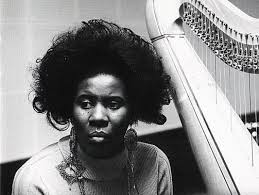Jazz harpist and pianist Alice Coltrane. Image via foundmichigan.org.
Repetition is often associated with boredom (“He kept repeating himself”), but note how some of our best insights arrive when we are engaged in some repetitive activity—walking, listening to the repeating rhythm of waves on the beach, and so forth. Those insights are less available to us when we are crossing the street against heavy traffic or greeting strangers in a crowded room, situations in which things keep changing. Repetition has the power to clear mental space, which we need in order to process things and enter more deeply into a work of art.
The short chord progression in Alice Coltrane’s “Journey in Satchidananda” repeats for the full length of the track. Notice how easily one can get a grip on what is happening and begin to think about it. Notice how repetition of the chord changes and of Cecil McBee’s bass line and Rashid Ali’s drum groove invite us to enter a trance-like listening, where our thoughts are given freedom to begin forming ideas. This repetition provides a backdrop to Alice Coltrane’s harp arpeggios. We are quickly able to put a framework around Pharoah Sanders’s solo; even his fastest runs feel easily understood as a result of the repetition behind it. The longer the track goes, the deeper our insights.
As you listen, consider this observation about repetition from producer and composer Brian Eno:
"Repetition doesn’t really exist. As far as your mind is concerned, nothing happens the same twice, even if in every technical sense, the thing is identical. Your perception is constantly shifting. It doesn’t stay in one place."
This is the magic of repetition, which can be the opposite of boring. Indeed, it can free us into reflection and insight.
Thank you for reading.
